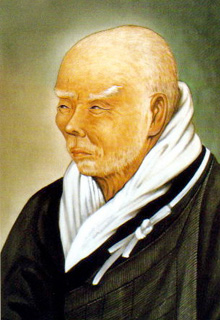Shinran Shonin
Shinran Sh onin (Shonin means holy man) was born at Hino near Kyoto, Japan, on May 21, 1173.
onin (Shonin means holy man) was born at Hino near Kyoto, Japan, on May 21, 1173.
Shinran was born into the aristocratic Hino family, a branch of the Fujiwara clan, and his father, Arinori, at one time served at court. At the age of nine, however, Shinran entered the Tendai temple on Mt. Hiei, where he spent twenty years in monastic life. From the familiarity with Buddhist writings apparent in his later works, it is clear that he exerted great effort in his studies during this period.
After twenty years, however, he despaired of ever attaining awakening through such discipline and study; he was also discouraged by the deep corruption that pervaded the mountain monastery. Years earlier, Honen Shonin (1133-1212) had descended Mt. Hiei and begun teaching a radically new understanding of religious practice, declaring that all self-generated efforts toward enlightenment were tainted by attachments and therefore meaningless. Instead of such practice, one should simply say the nembutsu, not as a contemplative exercise or means of gaining merit, but by way of wholly entrusting oneself to Amida’s Vow to bring all beings to enlightenment.
When he was twenty-nine, Shinran undertook a long retreat at Rokkakudo temple in Kyoto to determine his future course. At dawn on the ninety-fifth day, Prince Shotoku appeared to him in a dream. Shinran took this as a sign that he should seek out Honen, and went to hear his teaching daily for a hundred days. He then abandoned his former Tendai practices and joined Honen’s movement.
The Buddhist priesthood was in an uproar. Here was a priest who taught liberation in the power of Amida which was contrary to the recognized religious traditions of the day — liberation through moral and mental discipline. Furthermore, he had violated the priestly code by taking upon himself a wife.
Both Shinran and Honen were banished from Kyoto. After many years in exile, Shinran finally settled at Inada, Hitachi Province, in 1217. Here at the age of 45, he wrote his most famous work, Kyo Gyo Shin Sho – Teaching, Practice, Shin and Attainment. This book considered the most important of Shinran’s writing, laid the doctrinal foundation of Jodo Shinshu.
He spent twenty-five years of his life in the provincial countries. In 1232 when he was 60, he turned his footsteps to Kyoto, arriving there in l235. Here he remained until his passing on January 16th, 1262, writing and preaching to the countless followers who came to hear the Teachings of the Nembutsu.